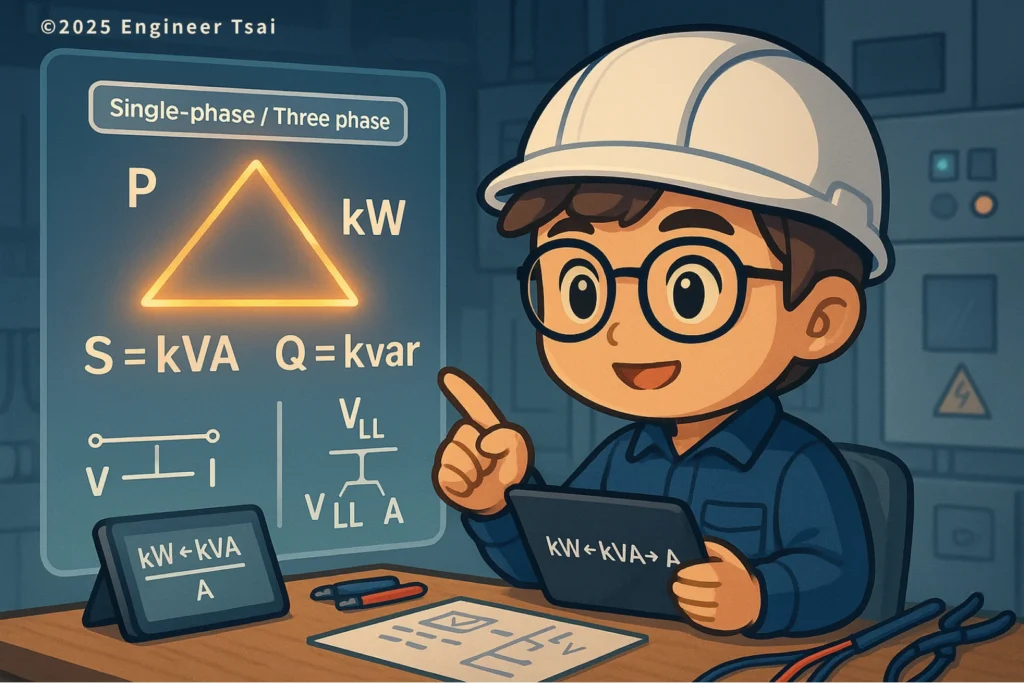In practice, this three phase power calculator gives you the fast numbers you need before you size a breaker or pull wire. Additionally, it also works as a single phase power calculator: enter voltage, current and power factor (PF), then solve for kW, kVA, kVAR or amps. Therefore, it’s tuned for 120/240 V and 208/240/277/480 V jobs.
Single / Three-Phase Power Calculator
Convert between P (kW), Q (kvar), S (kVA), current (A) with single- or three-phase systems.
Result
- P (kW):
- S (kVA):
- Q (kvar):
- I (A):
*For three-phase, enter line-to-line voltage V_LL. Formula: S=√3·V_LL·I, P=S·PF.
For education only. Verify with applicable codes and field conditions.

Three phase power calculator — quick start
Why it matters
in real jobs, mixing up kW vs kVA or forgetting PF leads to change orders, nuisance trips, and callbacks. Therefore, doing the power-triangle math up front saves both time and money.
How to use three phase power calculator
- System — pick Single-phase or Three-phase.
- Solve for — choose what you need: kW, kVA, kVAR or Amps.
- Enter inputs — voltage (use line-to-line for three-phase), the known current or power, and PF (0–1).
- Calculate — you’ll get an answer plus the other triangle values. If something looks off, adjust PF or verify whether you used VL-L vs VL-N.
Tip: For motors, PF varies with loading. As a result, nameplate PF or measured PF gives better amp estimates than guessing 1.0.
Power-triangle refresher (kW, kVA, kVAR)
- kW (P) — real power that does the work (heat, torque, light).
- kVA (S) — apparent power seen by the source.
- kVAR (Q) — reactive power from magnetizing/charging currents.
- PF = kW / kVA. Therefore, for a given kW, a lower PF means higher amps.
Core formulas (balanced systems):
- Single-phase:
- kW = V × I × PF
- kVA = V × I
- Three-phase (use line-to-line voltage VL-L):
- kW = √3 × VL-L × I × PF
- kVA = √3 × VL-L × I
- Reactive: kVAR = √(kVA² − kW²) = kW × tan(arccos PF)
Field examples you can sanity-check
- Amps from kW (3ϕ 480 V): 10 kW at PF 0.90 → I ≈ 10,000 / (√3 × 480 × 0.90) ≈ 13.4 A.
- kW from amps (1ϕ 240 V): I = 40 A, PF 0.95 → kW = 240 × 40 × 0.95 = 9.12 kW.
- kVAR from kW & PF: 20 kW at PF 0.80 → kVAR = 20 × tan(arccos 0.80) ≈ 15 kVAR.
- Heads-up: If your three-phase voltage is 208 V (wye), remember it’s line-to-line. Otherwise, using 120 V will under-estimate amps by roughly √3.
When to use three phase power calculator vs other tools
- Sizing feeders and services — start here to get kW/kVA and Amps, then jump to your Wire Size or Voltage Drop tool.
- Motor / EVSE planning — use actual PF if you have it; in addition, consider inrush and duty cycle when selecting OCPD and conductors.
- Generator / UPS estimates — convert kW ↔ kVA quickly and pick a sensible PF; meanwhile, leave margin for starting loads.
- Panel balancing — calculate each large load; consequently, you’ll keep phases even and the neutral cool.
Common mistakes (and how to avoid them)
- Using VL-N on three-phase — the math expects VL-L. Double-check your meter readout.
- Assuming PF = 1 — lighting with modern drivers may be close, but motors and welders rarely are.
- Confusing hp with kW — don’t forget motor efficiency and PF; hp × 0.746 gives shaft kW only.
- Unbalanced loads — this calculator assumes balanced three-phase; if not, solve phase by phase.
Practical workflow (fast and repeatable)
- Estimate PF from nameplate or past jobs.
- Solve for amps, then check breaker and conductor against ampacity and temperature corrections.
- Therefore, if voltage drop is near your target, upsize the conductor now rather than fixing callbacks later.
- Finally, document assumptions (PF, efficiency, duty) in your notes or quote.
Extended reading & internal resources about three phase power calculator
- Voltage Drop Calculator
- Wire Size & Ampacity →
/wire-size-ampacity - Panel upgrades & breaker selection →
/panel-upgrade - AFCI/GFCI protection basics →
/afci-gfci-guide
References (open in a new tab)
- Power triangle and PF basics
- Engineering Toolbox — common line voltages and relationships (VL-L vs VL-N)
Disclaimer: This power calculator is for education and pre-design checks. Final selections must follow the NEC and local amendments, equipment listings, and your AHJ or project engineer.
FAQ
Use line-to-line (VL-L) for these formulas. Otherwise, your amps will be under-estimated by about √3.
Lighting with modern drivers may be ~0.95–0.99; small motors might be 0.75–0.90; welders and VFDs vary. Therefore, confirm whenever possible.
No—efficiency is separate from PF. For motors, convert horsepower to shaft kW (hp × 0.746), then divide by efficiency to get input kW before applying PF.
Yes. Meanwhile, use 120/240 V for residential and 208/240/277/480 V for commercial; the math updates instantly.
